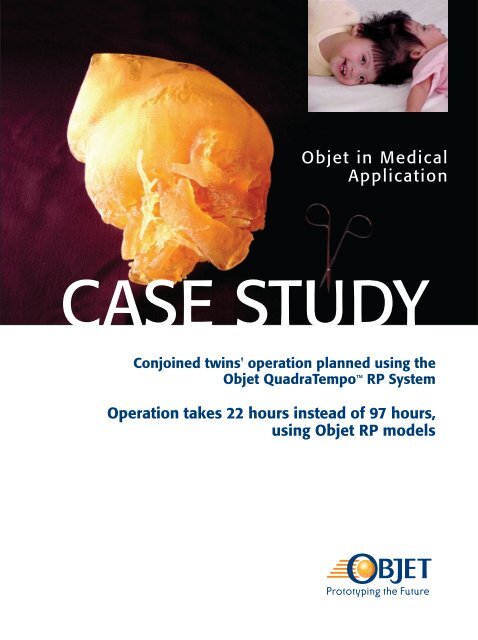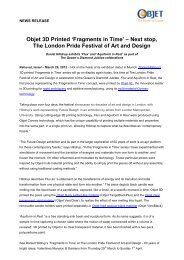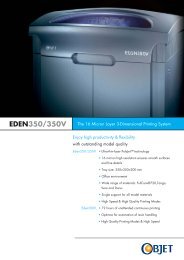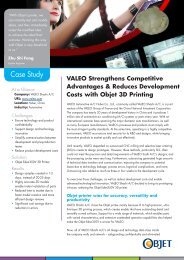UCLA Medical Center - Objet Geometries
UCLA Medical Center - Objet Geometries
UCLA Medical Center - Objet Geometries
You also want an ePaper? Increase the reach of your titles
YUMPU automatically turns print PDFs into web optimized ePapers that Google loves.
<strong>Objet</strong> in <strong>Medical</strong><br />
Application<br />
CASE STUDY<br />
Conjoined twins' operation planned using the<br />
<strong>Objet</strong> QuadraTempo RP System<br />
Operation takes 22 hours instead of 97 hours,<br />
using <strong>Objet</strong> RP models<br />
Prototyping the Future
says that "similar procedures in the past have taken as<br />
long as 97 hours. Part of the time savings almost certainly<br />
was attributable to the RP models."<br />
The QuadraTempo system builds parts by selectively jetting<br />
tiny droplets of acrylic photopolymer creating layers and<br />
then curing layer-by-layer, using UV light. A second, gellike<br />
photopolymer material is used for support and is<br />
wiped off or removed by water jets.<br />
"We're so pleased to see that our technology was chosen<br />
for this humane undertaking, and this example is just one<br />
of many that we have envisioned for our company," says<br />
<strong>Objet</strong> <strong>Geometries</strong>' CEO Hanan Yosefi. "We believe that<br />
there are many benefits the <strong>Objet</strong> QuadraTempo can offer<br />
the medical community in applying prototyping for medical<br />
modeling and other essential applications."<br />
About the <strong>Objet</strong> Product Line<br />
<strong>Objet</strong> product line systems provide high-quality, 3D<br />
models quickly and conveniently throughout the design<br />
process. They enable manufacturers and industrial<br />
designers to reduce product-development cycles and<br />
dramatically decrease time-to-market of new products<br />
in many industries.<br />
“No matter how good our<br />
3-D graphics are, there is<br />
nothing like a model in<br />
your hands . . .<br />
Many thanks again for<br />
your wonderful support.”<br />
Henry K. Kawamoto, Jr.,<br />
M.D., D.D.S. <strong>UCLA</strong><br />
<strong>Medical</strong> <strong>Center</strong><br />
The <strong>Objet</strong> product line RP system is based on <strong>Objet</strong>’s<br />
innovative PolyJet polymer jetting technology. It jets<br />
layer upon layer of an <strong>Objet</strong>-developed photopolymer;<br />
each layer is cured by exposure to UV light. <strong>Objet</strong> RP<br />
systems’ innovative design incorporates advances in<br />
software, electronics, mechanical design and materials.<br />
About <strong>Objet</strong> <strong>Geometries</strong><br />
<strong>Objet</strong> develops, produces and markets rapid prototyping<br />
systems and resins that utilize PolyJet - proprietary<br />
polymer jetting technology. Models are created directly<br />
from CAD files using an innovative, multidisciplinary<br />
approach to hardware, software and polymer materials.<br />
<strong>Objet</strong> is the only company to offer a balance of accurate,<br />
clean, smooth and detailed prototypes, on an easy-touse<br />
platform, all at an affordable price.<br />
<strong>Objet</strong>’s customers in the US, Europe, Asia and Australia<br />
include world leaders in numerous industries: toys,<br />
electronics, automotive, consumer goods, and footwear.<br />
The company has distribution partners all around the<br />
globe.<br />
<strong>Objet</strong> <strong>Geometries</strong> was founded in 1998 and is based<br />
in Rehovot, Israel. For more details, please visit our<br />
website: http://www.2objet.com
Rehovot, Israel, September 5, 2002<br />
<strong>Objet</strong> <strong>Geometries</strong>' QuadraTempo system<br />
for building highly accurate 3D models was<br />
used to plan the successful separation of<br />
conjoined twins in Los Angeles last month.<br />
Guatemalan twins Maria Teresa and Maria de Jesus Quiej-<br />
Alvarez were born joined at the head on July 24, 2001.<br />
The twins' brains were separate and complete, with<br />
separated arteries and a dividing membrane. The veins<br />
draining the blood, however, were interwoven and fed into<br />
each others' circulatory system. Separating conjoined twins<br />
is a highly complicated procedures, but surgeons at the<br />
University of California's Mattel Children's Hospital<br />
determined that an operation was possible. The most<br />
complex part of the operation was to sort out the veins<br />
and reroute the twins' blood supply. Because the blood<br />
vessels were crisscrossed, tracking them using standard,<br />
two-dimensional x-rays would be impossible. One of the<br />
hospitals' doctors suggested using 3-dimensional rapid<br />
prototyping to help the plastic surgeons practice how to<br />
separate the girls' brain skulls, reroute the blood supply<br />
and plan skin grafting to cover the separated brains.<br />
Boston-based Biomedical Modeling Inc. (BMI), an RP<br />
fabricator for medical uses, handled the process. The <strong>UCLA</strong><br />
team had to supply BMI with three CT scans at different<br />
angles – it wasn't possible to arrange the twins for one<br />
scan. The company registered and combined the scans of<br />
the twins' brains and the intersection of the two skulls into<br />
a single, 3d model. BMI then used Materialise's MIMICs<br />
software to merge the scans and process the data, including<br />
a biomodel of the skull that included the maze of blood<br />
vessels. BMI asked InterPRO a Connecticut-based RP service<br />
bureau, to build the three models. "We determined that<br />
the QuadraTempo was the best choice for building these<br />
highly detailed models with the high accuracy needed.,"<br />
says InterPRO co-owner Kevin Dyer. "The QuadraTempo's<br />
ability to build the delicate features without support<br />
structures allowed us to clean the models much more<br />
easily after printing them. The fine details in the<br />
Tempo models proved especially critical to achieving<br />
success, since the surgeons needed to look inside the<br />
model and plan the rerouting of the blood vessels."<br />
The operation to separate the Quiej-Alvarez twins on August<br />
5 took about 22 hours. Biomedical founder Eitan Priluck
www.2objet.com<br />
info@2objet.com<br />
<strong>Objet</strong> <strong>Geometries</strong> Inc. <strong>Objet</strong> <strong>Geometries</strong> Europe S.A. <strong>Objet</strong> <strong>Geometries</strong> Ltd.<br />
© 2002 <strong>Objet</strong> <strong>Geometries</strong>, Ltd.<br />
1199 Route 22 East<br />
Mountainside, NJ 07092<br />
Ikaros Business Park<br />
Ikaroslaan 18, 1930 Zaventem<br />
Headquarters<br />
2 Holzman St., Science Park<br />
P.O. Box 2496, Rehovot 76124<br />
<strong>Objet</strong>, <strong>Objet</strong> <strong>Geometries</strong>, Quadra,<br />
<strong>Objet</strong> Quadra, <strong>Objet</strong> QuadraTempo,<br />
FullCure and <strong>Objet</strong> Studio are<br />
trademarks of <strong>Objet</strong> <strong>Geometries</strong> Ltd.<br />
USA<br />
Tel. 908-228-5400<br />
Fax. 908-228-5415<br />
Belgium<br />
Tel. +32-2-717-6511<br />
Fax. +32-2-717-6500<br />
Israel<br />
Tel. +972-8-931-4314<br />
Fax. +972-8-931-4315<br />
and may be registered in certain<br />
jurisdictions. All other trademarks<br />
belong to their respective owners.<br />
Cat. BRC-011102







